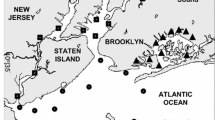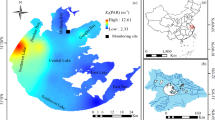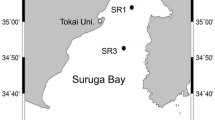Abstract
The coefficient of attenuation of photosynthetically active radiation (Kd(PAR)) and the depth of the euphotic zone (Deu) are widely used to study biogeochemical processes and eutrophication in marine ecosystems. However, determination of Kd(PAR) and Deu in estuaries is hampered by the simultaneous influence of many environmental factors. In this study, we analyzed the relationship between water turbidity (Turb), Kd(PAR), Deu, and environmental variables in the Neva Estuary, the largest estuary in the Baltic Sea. The summer values of Kd(PAR) and Deu were significantly higher than in the open waters of the Baltic Sea and varied in the range of 0.5–9.1 m−1 and 0.5–8.5 m, respectively. Mixed-effects regression analysis showed that the concentration of suspended mineral matter primarily determined the Turb. This variable fluctuated widely due to frequent wind-induced resuspension of bottom sediments and the periodic construction of port infrastructure in the shallow upper reaches of the estuary. Deu was determined by the depth of the water area, concentration of chlorophyll a, and concentrations of suspended mineral and organic matter. The average efficiency of using PAR energy for gross primary production (PP) was about 2%. However, PP did not depend on the amount of radiation incident on the water surface, but was mostly determined by underwater light and nutrient conditions. The study showed that more research on the impact of environmental variables on underwater light conditions in different regions is needed to predict the impact of climate change and anthropogenic factors on phytoplankton productivity in coastal areas.







Similar content being viewed by others
Data Availability
Original data available upon request and will be provided immediately.
References
Alikas, K., and S. Kratzer. 2017. Improved retrieval of Secchi depth for optically-complex waters using remote sensing data. Ecological Indicators. https://doi.org/10.1016/j.ecolind.2017.02.007.
Armengol, J., L. Caputo, M. Comerma, C. Feijoó, J.C. García, R. Marcé, E. Navarro, and J. Ordoñez. 2003. Sau reservoir’s light climate: relationships between Secchi depth and light extinction coefficient. Limnetica. http://refhub.elsevier.com/S0048-9697(21)00223-0/rf0005.
Arst, H. 2003. Optical Properties and Remote Sensing of Multicomponental Water Bodies. Berlin: Springer-Verlag.
Arst, H., T. Nõges, P. Nõges, and B. Paavel. 2008. Relations of phytoplankton in situ primary production, chlorophyll concentration and underwater irradiance in turbid lakes. Hydrobiologia. https://doi.org/10.1007/s10750-007-9213-z.
Bates, D., M. Mächler, B. Bolker, and S. Walker. 2015. Fitting linear mixed-effects models using lme4. Journal of Statistical Software. https://doi.org/10.18637/jss.v067.i01.
Barton, K. 2022. MuMIn: multi-model inference. https://cran.r-project.org/web/packages/MuMIn/index.html. Accessed 02 Nov 2022.
Behrenfeld, M.J., and P.G. Falkowski. 1997. A consumer’s guide to phytoplankton primary productivity models. Limnology and Oceanography. https://doi.org/10.4319/lo.1997.42.7.1479.
Bianchi, T.S. 2007. Biogeochemistry of estuaries. Oxford: University Press.
Bird, S. M., M. S. Fram, and K. L. Crepeau. 2003. Method of analysis by the U.S. Geological Survey California District Sacramento Laboratory—Determination of dissolved organic carbon in water by high temperature catalytic oxidation, method validation, and quality-control practices. In Open–file report 03–366. U.S. Geological Survey. Ed. U.S.G. Survey. http://pubs.usgs.gov/of/2003/ofr03366/text.html. Accessed 02 Nov 2022.
Christian, D., and Y.P. Sheng. 2003. Relative influence of various water quality parameters on light attenuation in Indian River Lagoon. Estuarine, Coastal and Shelf Science. https://doi.org/10.1016/S0272-7714(03)00002-7.
Chupakova, A.A., A.V. Chupakov, N.V. Neverova, L.S. Shirokova, and O.S. Pokrovsky. 2018. Photodegradation of river dissolved organic matter and trace metals in the largest European Arctic estuary. Science of the Total Environment. https://doi.org/10.1016/j.scitotenv.2017.12.0.
De Wit, H.A., S. Valinia, G.A. Weyhenmeyer, M.N. Futter, P. Kortelainen, K. Austnes, D.O. Hessen, A. Räike, H. Laudon, and J. Vuorenmaa. 2016. Current browning of surface waters will be further promoted by wetter climate. Environmental Science & Technology Letters. https://doi.org/10.1021/acs.estlett.6b00396.
Devlin, M.J., J. Barry, D.K. Mills, R.J. Gowen, J. Foden, D. Siver, and P. Tett. 2008. Relationships between suspended particulate material, light attenuation and Secchi depth in UK marine waters. Estuarine, Coastal and Shelf Science. https://doi.org/10.1016/j.ecss.2008.04.024.
Domingues, R.B., T.P. Anselmo, A.B. Barbosa, U. Sommer, and H.M. Galvao. 2011. Light as a driver of phytoplankton growth and production in the freshwater tidal zone of a turbid estuary. Estuarine, Coastal and Shelf Science.
Downing, B.D., B.A. Pellerin, B.A. Bergamaschi, J.F. Saraceno, and T.E.C. Kraus. 2012. Seeing the light: The effects of particles, dissolved materials, and temperature on in situ measurements of DOM fluorescence in rivers and streams. Limnology and Oceanography Methods. https://doi.org/10.4319/lom.2012.10.767.
Eilola, K., H.E.M. Meier, and E. Almroth. 2009. On the dynamics of oxygen, phosphorus and cyanobacteria in the Baltic Sea; a model study. Journal of Marine Systems. https://doi.org/10.1016/j.jmarsys.2008.08.009.
Emelyanov, E.M. 2003. Barrier zones in the oceans. Berlin: Springer-Verlag.
Fogel, M.L., L.A. Cifuentes, D.J. Velinsky, and J.H. Sharp. 1992. Relationship of carbon availability in estuarine phytoplankton to isotopic composition. Marine Ecology Progress Series. 82: 291–300.
Fry, B. 1996. 13C/12C fractionation by marine diatoms. Marine Ecology Progress Series. 134: 283–294.
Golubkov, M., and S. Golubkov. 2020. Eutrophication in the Neva Estuary (Baltic Sea): Response to temperature and precipitation patterns. Marine and Freshwater Research. https://doi.org/10.1071/MF18422.
Golubkov, M., and S. Golubkov. 2021. Relationships between northern hemisphere teleconnection patterns and phytoplankton productivity in the Neva Estuary (Northeastern Baltic Sea). Frontiers in Marine Science. https://doi.org/10.3389/fmars.2021.735790.
Golubkov, M., and S. Golubkov. 2022. Impact of the Construction of New Port Facilities on Primary Production of Plankton in the Neva Estuary (Baltic Sea). Frontiers in Marine Science. https://doi.org/10.3389/fmars.2022.851043.
Golubkov, M., V. Nikulina, and S. Golubkov. 2019b. Effects of environmental variables on midsummer dinoflagellate community in the Neva Estuary (Baltic Sea). Oceanologia. https://doi.org/10.1016/J.OCEANO.2018.09.001.
Golubkov, M.S., V.N. Nikulina, and S.M. Golubkov. 2021. Species-level associations of phytoplankton with environmental variability in the Neva Estuary (Baltic Sea). Oceanologia. https://doi.org/10.1016/j.oceano.2020.11.002.
Golubkov, M.S., V.N. Nikulina, A.V. Tiunov, and S.M. Golubkov. 2020. Stable C and N isotope composition of suspended particulate organic matter in the Neva Estuary: The role of abiotic factors, productivity, and phytoplankton taxonomic composition. Journal of Marine Science and Engineering. https://doi.org/10.3390/jmse8120959.
Golubkov, S., M. Golubkov, A. Tiunov, and V. Nikulina. 2017. Long-term changes in primary production and mineralization of organic matter in the Neva Estuary (Baltic Sea). Journal of Marine Systems. https://doi.org/10.1016/j.jmarsys.2016.12.009.
Golubkov, S.M., M.S. Golubkov, and A.V. Tiunov. 2019a. Anthropogenic carbon as a basal resource in the benthic food webs in the Neva Estuary (Baltic Sea). Marine Pollution Bulletin. https://doi.org/10.1016/j.marpolbul.2019.06.037.
Gomes, A.C., E. Alcântara, T. Rodrigues, and N. Bernardo. 2020. Satellite estimates of euphotic zone and Secchi disk depths in a colored dissolved organic matter-dominated inland water. Ecological Indicators. https://doi.org/10.1016/j.ecolind.2019.105848.
Grasshoff, K., M. Ehrhardt, and K. Kremling. 1999. Methods of Seawater Analysis, 3rd. Completely revised and Extended. New York: Wiley-VCH.
Harvey, E.T., J. Walve, A. Andersson, B. Karlson, and S. Kratzer. 2019. The effect of optical properties on Secchi depth and implications for eutrophication management. Frontiers in Marine Science. https://doi.org/10.3389/fmars.2018.00496.
International Organization for Standardization (ISO). 2022. Country Codes–ISO 3166. https://www.iso.org/iso-3166-country-codes.html. Accessed 14 Jul 2022.
Jones, R., I. and L. Arvola. 1984. Light penetration and some related characteristics in small forest lakes in Southern Finland. SIL Proceedings 1922–2010. https://doi.org/10.1080/03680770.1983.11897390
Kari, E., I. Merkouriadi, J. Walve, M. Leppäranta, and S. Kratzer. 2018. Development of under-ice stratification in Himmerfjärden bay, North-Western Baltic proper, and their effect on the phytoplankton spring bloom. Journal of Marine Systems. https://doi.org/10.1016/j.jmarsys.2018.06.004.
Kim, S.-H., C.-S. Yang, and K. Ouchi. 2015. Spatio-temporal patterns of Secchi depth in the waters around the Korean Peninsula using MODIS data. Estuarine, Coastal and Shelf Science. https://doi.org/10.1016/j.ecss.2015.07.003.
Kirk, J.T.O. 2011. Light and Photosynthesis in Aquatic Ecosystems, 3rd ed. Cambridge: Cambridge University Press.
Kottek, M., J. Grieser, C. Beck, B. Rudolf, and F. Rubel. 2006. World Map of the Köppen-Geiger climate classification updated. Meteorologische Zeitschrift. https://doi.org/10.1127/0941-2948/2006/0130.
Kratzer, S., and G. Moore. 2018. Inherent optical properties of the Baltic Sea in comparison to other seas and oceans. Remote Sensing. https://doi.org/10.3390/rs10030418.
Kratzer, S., and P. Tett. 2009. Using bio-optics to investigate the extent of coastal waters: A Swedish case study. Hydrobiologia. https://doi.org/10.1007/s10750-009-9769-x.
Kratzer, S., D. Kyryliuk, M. Edman, P. Philipson, and S.W. Lyon. 2019. Synergy of satellite, in situ and modelled data for addressing the scarcity of water quality information for eutrophication assessment and monitoring of Swedish coastal waters. Remote Sensing. https://doi.org/10.3390/rs11172051.
Kuznetsova, A., P.B. Brockhoff, and R.H.B. Christensen. 2017. lmerTest package: tests in linear mixed effects models. Journal of Statistical Software. https://doi.org/10.18637/jss.v082.i13
Larsen, S., T. Andersen, and D.O. Hessen. 2011. Climate change predicted to cause severe increase of organic carbon in lakes. Global Change Biology. https://doi.org/10.1111/j.1365-2486.2010.02257.x.
Lawson, S.E., P.L. Wiberg, K.J. McGlathery, and D.C. Fugate. 2007. Wind driven sediment suspension controls light availability in a shallow coastal lagoon. Estuaries and Coasts. https://doi.org/10.1111/j.1365-2486.2010.02257.x.
Lee, Z.P., K.L. Carder, J. Marra, R.G. Steward, and M.J. Perry. 1996. Estimating primary production at depth from remote sensing. Applied Optics. https://doi.org/10.1364/AO.35.000463.
LI-COR. 2022. LI-193 Spherical Underwater Quantum Sensor https://www.licor.com/env/products/light/quantum_underwater_sphere. Accessed 09 Nov 2022.
Lisitzin, A.P. 1999. The continental-ocean boundary as a marginal filter in the world oceans. In Biogeochemical cycling and sediment ecology, ed. J.S. Gray, W. Ambrose, and A. Szaniawska, 69–103. Dordrecht: Springer.
Lund-Hansen, L.C. 2004. Diffuse attenuation coefficients Kd(PAR) at the estuarine North Sea-Baltic Sea transition: Time-series, partitioning, absorption and scattering. Estuarine, Coastal and Shelf Science. https://doi.org/10.1016/j.ecss.2004.05.004.
Martyanov, S., and V. Ryabchenko. 2016. Bottom sediment resuspension in the easternmost Gulf of Finland in the Baltic Sea: A case study based on three–dimensional modeling. Continental Shelf Research. https://doi.org/10.1016/j.csr.2016.02.011.
McMahon, T.G., R.C.T. Raine, T. Fast, L. Kies, and J.W. Patching. 1992. Phytoplankton biomass, light attenuation and mixing in the Shannon estuary, Ireland. Journal of the Marine Biological Association of the UK. https://doi.org/10.1017/S0025315400059464.
Meteoblue. 2022. Climate Zones. https://content.meteoblue.com/en/meteoscool/general-climate-zones. Accessed 09 Nov 2022.
Morel, A., and R.C. Smith. 1974. Relation between total quanta and total energy for aquatic photosynthesis. Limnology and Oceanography. https://doi.org/10.4319/lo.1974.19.4.0591.
Mueller, J.L. 2000. SeaWiFS algorithm for the diffuse attenuation coefficient, K(490), using water-leaving radiances at 490 and 555 nm. In SeaWiFS Postlaunch Calibration and Validation Analyses, Part 3, eds. S.B. Hooker, and E.R. Firestone, 24–27. Greenbelt: NASA GSFC.
Neumann, T., H. Siegel, and M. Gerth. 2015. A new radiation model for Baltic Sea ecosystem modelling. Journal of Marine Systems. https://doi.org/10.1016/j.jmarsys.2015.08.001.
Nõges, T., ed. 2001. Lake Peipsi: Meteorology, hydrology, hydrochemistry. Tartu: Sulemees Publishers.
O’Gorman, E.J., O.P. Olafsson, B.O.L. Demars, N. Friberg, G. Gudbergsson, E.R. Hannesdottir, M.C. Jackson, L.S. Johansson, O.B. Mclaughlin, J.S. Olafsson, G. Woodward, and G.M. Gislason. 2016. Temperature effects on fish production across a natural thermal gradient. Global Change Biology. https://doi.org/10.1111/gcb.13233.
Pedersen, T.M., K. Sand-Jensen, S. Markager, and S.L. Nielsen. 2014. Optical changes in a eutrophic estuary during reduced nutrient loadings. Estuaries and Coasts. https://doi.org/10.1007/s12237-013-9732-y.
Philips, E.J., T.C. Lynch, and S. Badylak. 1995. Chlorophyll a, tripton, color, and light availability in a shallow tropical inner-shelf lagoon, Florida Bay, USA. Marine Ecology Progress Series. https://doi.org/10.3354/meps127223.
Pierson, D.C., S. Kratzer, N. Strömbeck, and B. Håkansson. 2008. Relationship between the attenuation of downwelling irradiance at 490 nm with the attenuation of PAR (400 nm–700 nm) in the Baltic Sea. Remote Sensing of Environment. https://doi.org/10.1016/j.rse.2007.06.009.
Riegmann, F., and F. Colijn. 1991. Evaluation of measurements and calculation of primary production in the Dogger Bank area (North Sea) in summer 1988. Marine Ecology Progress Series 69: 125–132.
Ryabchuk, D., V. Zhamoida, M. Orlova, A. Sergeev, J. Bublichenko, A. Bublichenko, and L. Sukhacheva. 2017. Neva Bay: A technogenic lagoon of the eastern Gulf of Finland (Baltic Sea). In The diversity of Russian estuaries and lagoons exposed to human Influence, ed. R. Kosyan, 191–221. Cham: Springer International Publishing.
Savchuk, O.P. 2002. Nutrient biogeochemical cycles in the Gulf of Riga: Scaling up field studies with a mathematical model. Journal of Marine Systems. https://doi.org/10.1016/S0924-7963(02)00039-8.
Shirokova, L.S., A.A. Chupakova, A.V. Chupakov, and O.S. Pokrovsky. 2017. Transformation of dissolved organic matter and related trace elements in the mouth zone of the largest European Arctic river: Experimental modeling. Inland Waters. https://doi.org/10.1080/20442041.2017.1329907.
Southgate, D., and J. Durnin. 1970. Calorie conversion factors. An experimental reassessment of the factors used in the calculation of the energy value of human diets. British Journal of Nutrition. https://doi.org/10.1079/BJN19700050.
Swift, T.J., J. Perez-Losada, S.G. Schladow, J.E. Reuter, A.D. Jassby, and C.R. Goldman. 2006. Water clarity modeling in Lake Tahoe: Linking suspended matter characteristics to Secchi depth. Aquatic Sciences. https://doi.org/10.1007/s00027-005-0798-x.
Team, R., Core. 2022. R: a language and environment for statistical computing. R Foundation for Statistical Computing. https://www.r-project.org. Accessed 9 Nov 2022.
Telesh, I.V., S.M. Golubkov, and A.F. Alimov. 2008. The Neva Estuary ecosystem. In Ecology of Baltic Coastal Waters, ed. U. Schiewer, 259–284. Berlin: Springer-Verlag.
Thrane, J.E., D.O. Hessen, and T. Andersen. 2014. The absorption of light in lakes: Negative impact of dissolved organic carbon on primary productivity. Ecosystems. https://doi.org/10.1007/s10021-014-9776-2.
Turner, J.S., P. St-Laurent, M.A.M. Friedrichs, and C.T. Friedrichs. 2021. Effects of reduced shoreline erosion on Chesapeake Bay water clarity. Science of the Total Environment. https://doi.org/10.1016/j.scitotenv.2021.145157.
Wang F., A. Umehara, S. Nakai, and W. Nishijima. 2019. Distribution of region-specific background Secchi depth in Tokyo Bay and Ise Bay, Japan. Ecological Indicators. https://doi.org/10.1016/j.ecolind.2018.11.015.
Winter B. 2013. Linear models and linear mixed effects models in R with linguistic applications. http://arxiv.org/pdf/1308.5499.pdf. Accessed 14 Jul 2022.
Zhang, M., Y. Zhou, Y. Zhang, K. Shi, C. Jiang, and Y. Zhang. 2020. Attenuation of UVR and PAR in a clear and deep lake: Spatial distribution and affecting factors. Limnologica. https://doi.org/10.1016/j.limno.2020.125798.
Acknowledgements
The authors thank the two reviewers for their constructive comments that significantly improved the early version of the manuscript.
Funding
The study was supported by Zoological Institute RAS (project 122031100274–7).
Author information
Authors and Affiliations
Contributions
All authors drafted, contributed to, and approved the manuscript.
Corresponding author
Additional information
Communicated by Paul A. Montagna
Supplementary Information
Below is the link to the electronic supplementary material.
Rights and permissions
Springer Nature or its licensor (e.g. a society or other partner) holds exclusive rights to this article under a publishing agreement with the author(s) or other rightsholder(s); author self-archiving of the accepted manuscript version of this article is solely governed by the terms of such publishing agreement and applicable law.
About this article
Cite this article
Golubkov, M., Golubkov, S. Photosynthetically Active Radiation, Attenuation Coefficient, Depth of the Euphotic Zone, and Water Turbidity in the Neva Estuary: Relationship with Environmental Factors. Estuaries and Coasts 46, 630–644 (2023). https://doi.org/10.1007/s12237-022-01164-9
Received:
Revised:
Accepted:
Published:
Issue Date:
DOI: https://doi.org/10.1007/s12237-022-01164-9




